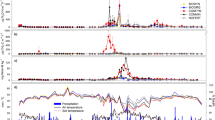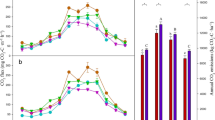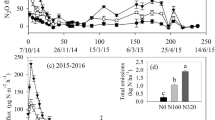Abstract
In this study, we investigated N2O emissions from two fields under minimum tillage, cropped with maize (MT maize) and summer oats (MT oats), and a conventionally tilled field cropped with maize (CT maize). Nitrous oxide losses from the MT maize and MT oats fields (5.27 and 3.64 kg N2O-N ha−1, respectively) were significantly higher than those from the CT maize field (0.27 kg N2O-N ha−1) over a period of 1 year. The lower moisture content in CT maize (43% water-filled pore space [WFPS] compared to 60–65%) probably caused the difference in total N2O emissions. Denitrification was found to be the major source of N2O loss. Emission factors calculated from the MT field data were high (0.04) compared to the CT field (0.001). All data were simulated with the denitrification decomposition model (DNDC). For the CT field, N2O and N2O + N2 emissions were largely overestimated. For the MT fields, there was a better agreement with the total N2O and N2O + N2 emissions, although the N2O emissions from the MT maize field were underestimated. The simulated N2O emissions were particularly influenced by fertilization, but several other measured N2O emission peaks associated with other management practices at higher WFPS were not captured by the model. Several mismatches between simulated and measured \({\text{NH}}_4^ + \), \({\text{NO}}_3^ - \) and WFPS for all fields were observed. These mismatches together with the insensitivity of the DNDC model for increased N2O emissions at the management practices different from fertilizer application explain the limited similarity between the simulated and measured N2O emissions pattern from the MT fields.




Similar content being viewed by others
References
Aulakh MS, Rennie DA, Paul EA (1984) Gaseous nitrogen losses from soils under zero-till as compared with conventional-till management systems. J Environ Qual 13:130–136
Baggs EM, Stevenson M, Pihlatie M, Regar A, Cook H, Cadisch G (2003) Nitrous oxide emissions following application of residues and fertiliser under zero and conventional tillage. Plant Soil 254:361–370
Beauchamp EG (1997) Nitrous oxide emission from agricultural soils. Can J Soil Sci 77:113–123
Beheydt D, Boeckx P, Sleutel S, Li C, Van Cleemput O (2007) Validation of DNDC for 22 long-term N2O field emission measurements. Atmos Environ 41:6196–6211
Chatskikh D, Olesen JE, Berntsen J, Regina K, Yamulki S (2005) Simulation of effects of soils, climate and management on N2O emission from grasslands. Biogeochemistry 76:395–419
Choudhary MA, Akramkhanov A, Saggar S (2002) Nitrous oxide emissions from a New Zealand cropped soil: tillage effects, spatial and seasonal variability. Agr Ecosys Environ 93:33–43
Davidson EA (1991) Fluxes of nitrous oxide and nitric oxide from terrestrial ecosystems. In: Rogers JE, Whitman WB (eds) Microbial production and consumption of greenhouse gases: methane, nitrogen oxides, and halomethanes. American Society for Microbiology, Washington DC, pp 219–235
Davidson EA, Swank WT, Perry TO (1986) Distinguishing between nitrification and denitrification as sources of gaseous nitrogen production in soil. Appl Environ Microbiol 52:1280–1286
Del Grosso SJ, Mosier AR, Parton WJ, Ojima DS (2005) DAYCENT model analysis of past and contemporary soil N2O and net greenhouse gas flux for major crops in the USA. Soil Tillage Res 83:9–24
De Visscher A, Goossens A, Van Cleemput O (2000) Calibration of a multipoint sampling system connected with a photoacoustic detector. Int J Environ Anal Chem 76:115–133
D’Haene K, Moreels E, De Neve S, Chaves Daguilar B, Boeckx P, Hofman G, Van Cleemput O (2003) Soil properties influencing the denitrification potential of Flemish agricultural soils. Biol Fertil Soil 38:358–366
Dobbie KE, Smith KA (2003) Nitrous oxide emission factors for agricultural soils in Great Britain: the impact of soil water-filled pore space and other controlling variables. Glob Chang Biol 9:204–218
Dobbie KE, McTaggart IP, Smith KA (1999) Nitrous oxide emissions from intensive agricultural systems: variations between crops and seasons, key driving variables, and mean emission factors. J Geophys Res 104:26891–26899
Flessa H, Dörsch P, Beese F (1995) Seasonal variation of N2O and CH4 fluxes in differently managed arable soils in southern Germany. J Geophys Res 109:23115–23124
Freibauer A, Kaltschmitt M (2003) Controls and models for estimating direct nitrous oxide emissions from temperate and sub-boreal agricultural mineral soils in Europe. Biogeochemistry 63:93–115
Freibauer A, Rounsevell MDA, Smith P, Verhagen A (2004) Carbon sequestration in the agricultural soils of Europe. Geoderma 122:1–23
Goossens A, De Visscher A, Boeckx P, Pauwels D, Van Cleemput O (2000) A compilation of non-CO2 trace gas measurements from different Belgian soils. In: Van Cleemput O, Vlassak K, Goossens A, De Wever H (eds) Non-CO2 trace gas emissions from Belgian soils: where research and policy meet. Ghent, October 24. Academia, Ghent, Belgium, pp 19–29
Granli T, Bøckman OC (1994) Nitrous oxide from agriculture. Norwegian J Agric Sci 12:1–128
Helgason BL, Janzen HH, Chantigny MH, Drury CF, Ellert BH, Gregorich EG, Lemke RL, Pattey E, Rochette P, Wagner-Riddle C (2005) Toward improved coefficients for predicting direct N2O emissions from soil in Canadian agroecosystems. Nutr Cycl Agroecosyst 72:87–99
Hutchinson GL, Mosier AR (1981) Improved soil cover method for field measurement of nitrous oxide fluxes. Soil Sci Soc Am J 45:311–316
IPCC (2001) Climate Change 2001: impacts, adaptation, and vulnerability. In: McCarthy JJ, Canziani OF, Leary NA, Dokken DJ, White KS (eds) Contribution of Working Group II to the Third Assessment Report of the Intergovernmental Panel on Climate change. Cambridge University Press, Cambridge, UK, p 1032
IPCC (2006) 2006 IPCC guidelines for national greenhouse gas inventories, vol. 4. Institute for Global Environmental Strategies, Tokyo, Japan, p 54 (chapter 11)
Kaharabata SK, Drury CF, Priesack E, Desjardins RL, McKenney DJ, Tan CS, Reynolds D (2003) Comparing measured and expert-N predicted N2O emissions from conventional till and no till corn treatments. Nutr Cycl Agroecosyst 66:107–118
Li CS (2000) Modeling trace gas emissions from agricultural ecosystems. Nutr Cycl Agroecosyst 58:259–276
Li C, Frolking S, Frolking TA (1992a) A model of nitrous oxide evolution from soil driven by rainfall events: 2. Model applications. J Geophys Res 97:9777–9783
Li C, Frolking S, Frolking TA (1992b) A model of nitrous oxide evolution from soil driven by rainfall events: 1. Model structure and sensitivity. J Geophys Res 97:9759–9776
Li C, Frolking S, Butterbach-Bahl K (2005) Carbon sequestration in arable soils is likely to increase nitrous oxide emissions, offsetting reductions in climate radiative forcing. Clim Change 72:321–338
Linn DM, Doran JW (1984) Aerobic and anaerobic microbial populations in no-till and plowed soils. Soil Sci Soc Am J 48:794–799
Mosier AR, Duxbury JM, Freney JR, Heinemeyer O, Minami K (1996) Nitrous oxide emissions from agricultural fields: assessment, measurement and mitigation. Plant Soil 181:95–108
Myers RA, Pepin P (1990) The robustness of lognormal-based estimators of abundance. Biometrics 46:1185–1192
Potter CS, Matson PA, Vitousek PM, Davidson EA (1996) Process modeling of controls on nitrogen trace gas emissions from soils world-wide. J Geophys Res 101:1361–1377
Robertson GP, Paul EA, Harwood RR (2000) Greenhouse gases in intensive agriculture: contributions of individual gases to the radiative forcing of the atmosphere. Science 289:1922–1925
Ruser R, Flessa H, Schilling R, Steidl H, Beese F (1998) Soil compaction and fertilization effects on nitrous oxide and methane fluxes in potato fields. Soil Sci Soc Am J 62:1587–1595
Ruser R, Flessa H, Schilling R, Beese F, Munch C (2001) Effect of crop-specific field management and N fertilization on N2O emissions from a fine-loamy soil. Nutr Cycl Agroecosyst 59:177–191
Ryden JC, Lund LJ, Letey J, Focht DD (1979) Direct measurement of denitrification loss from soils: II. Development and application of field methods. Soil Sci Soc Am J 43:110–118
Six J, Elliott ET, Paustian K (1999) Aggregate and soil organic matter dynamics under conventional and no-tillage systems. Soil Sci Soc Am J 63:1350–1358
Six J, Feller C, Denef K, Ogle SM, de Moraes JFL, Albrecht A (2002) Soil organic matter, biota and aggregation in temperate and tropical soils—effects of no-tillage. Agronomie 22:755–775
Six J, Ogle SM, Breidt FJ, Conant RT, Mosier AR, Paustian K (2004) The potential to mitigate global warming with no-tillage management is only realized when practised in the long term. Glob Chang Biol 10:155–160
Skiba U, Smith KA (2000) The control of nitrous oxide emissions from agricultural and natural soils. Chemosphere 2:379–386
Sleutel S, De Neve S, Hofman G, Boeckx P, Beheydt D, Van Cleemput O, Mestdagh I, Lootens P, Carlier L, Van Camp N, Verbeeck H, Vande Walle I, Samson R, Lust N, Lemeur R (2003) Carbon stock changes and carbon sequestration potential of Flemish cropland soils. Glob Chang Biol 9:1193–1203
Smith P, Goulding KW, Smith KA, Powlson DS, Smith JU, Falloon P, Coleman K (2001) Enhancing the carbon sink in European agricultural soils: including trace gas fluxes in estimates of carbon mitigation potential. Nutr Cycl Agroecosyst 60:237–252
Smith WN, Desjardins RL, Grant B, Li C, Lemke R, Rochette P, Corre MD, Pennock D (2002) Testing the DNDC model using N2O emissions at two experimental sites in Canada. Can J Soil Sci 82:365–374
van Groeningen JW, Kasper GJ, Velthof GL, van den Pol-van Dasselaar A, Kuikman PJ (2004) Nitrous oxide emissions from silage maize fields under different mineral nitrogen fertilizer and slurry applications. Plant Soil 263:101–111
Veldkamp E, Keller M, Nuñez M (1998) Effects of pasture management on N2O and NO emissions from soils in the humid tropics of Costa Rica. Glob Biogeochem Cycles 12:71–79
Velthof GL, Oenema O (1995) Nitrous oxide fluxes from grassland in the Netherlands: I. Statistical analysis of flux-chamber measurements. Eur J Soil Sci 46:533–540
Venterea RT, Burger M, Spokas KA (2005) Nitrogen oxide and methane emissions under varying tillage and fertilizer management. J Environ Qual 34:1467–1477
Vereecken H, Maes J, Feyen J, Darius P (1989) Estimating the soil moisture retention characteristic from texture, bulk density, and carbon content. Soil Sci 148:389–403
Vermoesen A, Van Cleemput O, Hofman G (1996) Long-term measurements of N2O emissions. Energy Convers Manage 37:1279–1284
Wagner-Riddle C, Thurtell GW, Kidd GK, Beauchamp EG, Sweetman R (1997) Estimates of nitrous oxide emissions from agricultural fields over 28 months. Can J Soil Sci 77:135–144
West TO, Post WM (2002) Soil organic carbon sequestration rates by tillage and crop rotation: a global data analysis. Soil Sci Soc Am J 66:1930–1946
Wright SF, Starr JL, Paltineanu IC (1999) Changes in aggregate stability and concentration of glomalin during tillage management transition. Soil Sci Soc Am J 63:1825–1829
Yoshinari T, Hynes R, Knowles R (1977) Acetylene inhibition of nitrous oxide reduction and measurement of denitrification and nitrogen fixation in soil. Soil Biol Biochem 9:177–183
Acknowledgement
We wish to thank the Federal Science Policy for financing the CASTEC project and the different farmers, especially Benoît, who allowed willingly the measurements to be made on their fields. We are also grateful to D. Kracher for her checking of the data used in the simulations.
Author information
Authors and Affiliations
Corresponding author
Rights and permissions
About this article
Cite this article
Beheydt, D., Boeckx, P., Ahmed, H.P. et al. N2O emission from conventional and minimum-tilled soils. Biol Fertil Soils 44, 863–873 (2008). https://doi.org/10.1007/s00374-008-0271-9
Received:
Revised:
Accepted:
Published:
Issue Date:
DOI: https://doi.org/10.1007/s00374-008-0271-9




